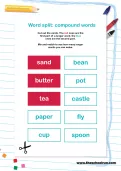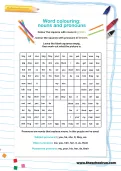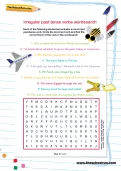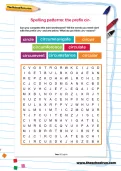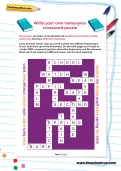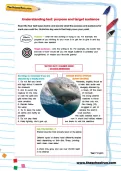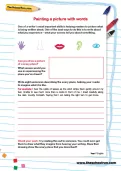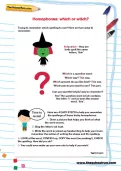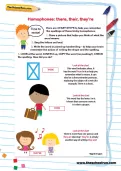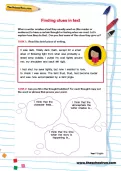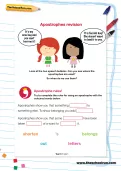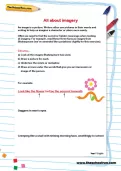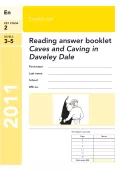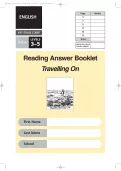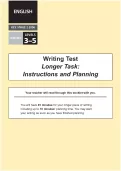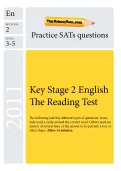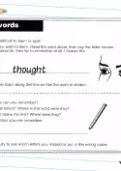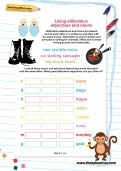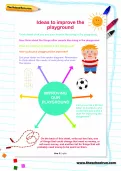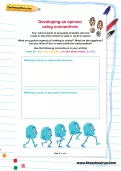This activity, aimed at Year 7 or advanced primary school pupils, will help your child analyse and break down a text to find evidence for their answers. What words have been used to create an impact? What images have been painted for the reader? Work through this activity step by step to practise reading comprehension.
or
Register to add to your saved resources
Already a subscriber? to view this content.
Time for some text analysis! Can your child identify the purpose and target audience of different types of text which all relate to the same subject? They will need to look for key words to help them prove their point.
or
Register to add to your saved resources
Already a subscriber? to view this content.
This worksheet will help improve your child's descriptive writing by encouraging them to draw on their sensory experiences. Can they describe a scary place through smell, hearing, sight, touch and taste? What will a reader picture after hearing their text?
or
Register to add to your saved resources
Already a subscriber? to view this content.
Is your child finding it hard to remember how to use and spell the homophones 'which' and 'witch'? Help them clear up the confusion with this practice worksheet.
or
Register to add to your saved resources
Already a subscriber? to view this content.
Help your child get a few difficult homophones straight with this worksheet. There, their and they're all sound the same, but their meanings are very different. Master the tricky spellings with a simple, four-step learning trick.
or
Register to add to your saved resources
Already a subscriber? to view this content.
Test reading comprehension skills with some thorough analysis of a short piece of text. What atmosphere, emotion and setting does the writer convey? What effective techniques are used? A KS3 worksheet, also suitable to stretch gifted Year 6 pupils.
or
Register to add to your saved resources
Already a subscriber? to view this content.
A revision worksheet to remind your child of the rules of correct apostrophe use. Can they reword sentences to show they understand when an apostrophe indicates belonging and when it's used to show that letters have been taken out of a word?
or
Register to add to your saved resources
Already a subscriber? to view this content.
Imagery is used in writing to help us imagine a place or character more clearly. This worksheet helps your child practise identifying imagery and then come up with their own metaphors and similes to enrich their descriptive writing.
or
Register to add to your saved resources
Download and print this complete 2011 English SATs papers pack and help your child to prepare for their SATs.
or
Register to add to your saved resources
Download and print this complete set of English SATs papers from 2005 to assist your child in preparing for the Year 6 tests.
or
Register to add to your saved resources
Download and print this complete set of KS2 English SATs papers from 2008 to assist your child in preparing for the tests.
or
Register to add to your saved resources
Download and print this complete set of English SATs papers from 2006 to help your child prepare for the tests.
or
Register to add to your saved resources
Our practice SATs papers have been compiled by teachers to offer your child extra practice when preparing for the Year 6 tests.
or
Register to add to your saved resources
Already a subscriber? to view this content.
This worksheet gives suggestions on how to memorise the spelling of the word 'thought'. The strategies here could be applied to other tricky words.
or
Register to add to your saved resources
Already a subscriber? to view this content.
This worksheet explains alliteration and gives examples of alliterative nouns and adjectives. Children are then encouraged to write their own alliterative sentences.
or
Register to add to your saved resources
Already a subscriber? to view this content.
This sheet consists of a text on adders for your child to read. They then need to make notes in the boxes to show that they understand how to group information by theme.
or
Register to add to your saved resources
Already a subscriber? to view this content.
This download prompts your child to think about ways in which their playground could be improved. They need to complete a spider-diagram of their ideas.
or
Register to add to your saved resources
Already a subscriber? to view this content.
This worksheet encourages children to listen to a spoken commentary and analyse it.
or
Register to add to your saved resources
Already a subscriber? to view this content.
This worksheet encourages children to think about the pros and cons of walking to school. It gives a list of connectives and suggests children use these in their writing.
or
Register to add to your saved resources
Already a subscriber? to view this content.
This worksheet encourages your child to imagine that they are writing an explanatory text for a child who is new to their school.
or
Register to add to your saved resources
Already a subscriber? to view this content.
